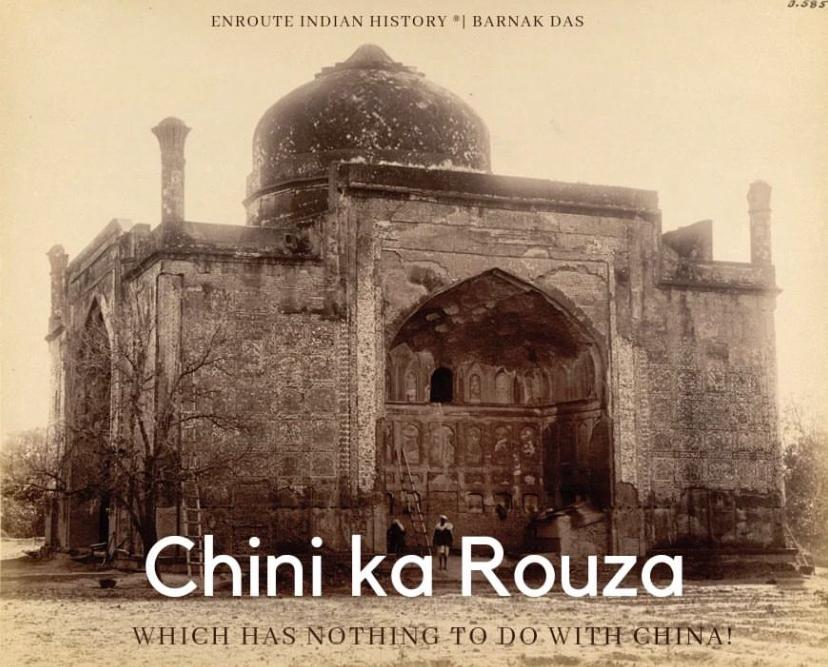The Lost History of Afzal Khans Tomb at Agra – The Chini-ka Rauza
- EIH User
- October 29, 2022

Article Written By EIH Researcher And Writer
Barnak Das
Under the aegis of the Mughals, Agra was a city to marvel at, both literally and figuratively. It was planned and constructed along the banks of a Yamuna much more effervescent than today, in a position where the river made a U-shaped turn. The right bank of the holy river was fortified in an irregular octagonal shape, housing both common and noble residences, markets, mosques, and chawks. A second fortification surrounded the imperial palaces and administrative buildings, a place that we identify as the Agra Fort today. On both banks of the river, lush green chahar baghgardens were constructed, many of which housed the tombs and mausoleums of the royal family and officials. The garden style employed in Agra was introduced by Babur when he first settled in the city, and later it was improvised to its fullest extent by Shah Jahan. During the rule of Shah Jahan, the city of Agra became a ‘riverfront garden city,’ housing as many as 7 lakh inhabitants inside its walls.

While most of the Mughal gardens and tombs in the city of Agra had suffered a good deal of damage due to centuries of shifting weather and political currents, some still survive to this day. Leaving aside the famous tourist spots like the Taj Mahal, Mehtab Bagh, Aram Bagh, and the garden housing the tomb of Itimad-ud-Daula, there are other structures too that once adorned the Mughal capital of India. One of them is the Chini-ka Rauza, which, contrary to its name, has nothing to do with China. The monument is situated on the left bank of Yamuna and was part of a series of riverfront garden complexes just opposite the city. It occupies the sixth position (no.6) in the map of Agra made by the Raja of Jaipur, starting from the northernmost position. Just before it is the garden of Jahanara, called the Zahra Bagh. The tomb of Itimad-ud-Daula, the best-preserved structure on the left bank, lies just a few gardens ahead. Thus, it can be said that theprime position of the monument highlights its significance, as the bank of Yamuna was real estate reserved only for the gardens and tombs of the most influential nobles.

The Chini-ka Rauza, also called the Rauza of Afzal Khan, is a square tomb that serves as a mausoleum of Mulla Shukrullah as-Shirazi, known as Allami Afzal Khan as-Shirazi. He was an Iranian noble who came to the Mughal court from his native home of Shiraz in 1608. He began imperial service under Jahangir and later rose the ranks to become the diwan-i-kul, or the finance minister of Shah Jahan. Shirazi held a rank of 7,000 zat and 4,000 sawar in the prime of his career. He was also good in poetry, astronomy, and mathematics and for this reason he was highly regarded by the emperor Shah Jahan. Shirazi died in 1639 at the age of seventy in Lahore. His body was bought to Agra to be buried in the Rauza, or tomb built for him during his lifetime. It is believed that his brother, Abd-ul Haqq, named Ammanat Khan, who carved the majestic inscriptions at the Taj Mahal, also designed the inscriptions on the Chini-ka Rauza.

The Chini-ka Rauza derives its name from the glazed porcelain tiles on its exterior walls. The porcelain tiles were imported from China and were commonly known as’chini mitti.’The building was covered with beautifully designed glazed tiles, decorated with Islamic calligraphy and flower decorations in the Lahore style of tilework, where the tiles are cut precisely to match the outlaying mosaic design. The Chini-ka Rauza is based on the hasht-behesht (eight paradises) plan having a central tomb with surrounding halls in a garden. The building combines design elements of Afghani and Persian architecture. The hasht-behesht, calligraphy work, and floral patterns are adopted from the Persian style, whereas the square-shaped plan with abulbous dome is adopted from the Afghani style of architecture. The Chini-ka Rauza is one of the few buildings of Agra mentioned by the Tyrolean Jesuit geographer Josef Tiefenthaler, who saw it in the 1740s; he comments on its ‘tegulis sinensimore incrustatis’ – its inlay with tiles in the Chinese manner.

With the decline of Mughal rule and gradual neglect over the years, the Chini-ka Rauza was vandalized for its beauty. After the British took over Agra in 1803, the Chini-ka Rauza was noted as a building of architectural merit, so it appears as a subject of’ Company drawings’ – water colours done with great attention to detail by Indian artists for British patrons. When Lord Hastings, the Governor-General of the East India Company, was in Agra in 1815, his artist Sita Ram made two views of ‘The China Roza’ in his characteristic soft and loose brushwork and aerial perspective”. Fanny Parks in 1835 criticized the fact that the tomb’s flanking buildings had been removed, that its decoration had been plundered for the gold components, and that farmers lived in it and tied their bullocks to the cenotaphs:”
In 1899, Lord Curzon, Governor-General and Viceroy of India, found ‘this exquisite little tomb in a shocking state of dilapidation’, and ordered its restoration. Since then, the Chini-ka Rauza has been repeatedly restored, particularly the outer tile facing and the inner painted decoration, which have lost much of their original character. It was preserved from further damage by the Archaeological Survey of India at the beginning of the 20th century. Much of what we know about the building today comes from the book “Mughal Colour Decorations of Agra” written by a colonial officer of the ASI named Edmund William Smith. Smith provides a complete survey of the monument with photographic plates and detailed written descriptions in his book.

The Chini-ka Rauza still stands at Agra as a marquee example of Mughal architecture. The beauty of it lies in its uniqueness – it is the only monument of Agra which had a glazed tile exterior and had its façade oriented not towards the Yamuna but Mecca.
References
Koch Ebba and Barraud Richard André. 2012. The Complete Taj Mahal and the Riverfront Gardens of Agra 1St pbk. ed. London: Thames & Hudson.
Smith Edmund W. 1901. Moghul Colour Decoration of Agra. Allahabad: Supdt. Govt. Press N.-W.P. & Oudh.

















